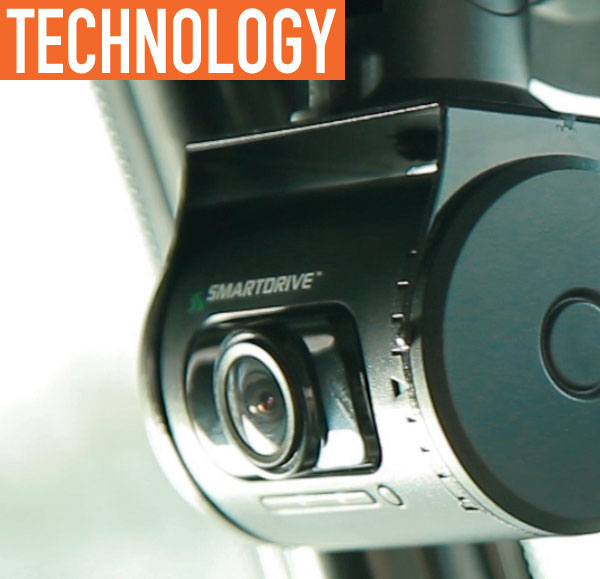Imagine that you are driving a company vehicle and start to exit the highway on a crowded New York City off-ramp when suddenly the passenger car next to you swerves into your lane and collides with your vehicle. Then imagine that car is being driven by an attorney, who claims you are at fault for the accident. Now your job, reputation, and a possible lawsuit are on the line.
This is an incident that actually happened to a Danella Companies’ employee, and it’s a perfect example of why vehicle safety cameras can be such a worthwhile addition to a comprehensive fleet safety program. Danella is a Pennsylvania-based provider of construction services to the utility industry. In its New York and Connecticut operation, the company operates a fleet of just under 200 vehicles, ranging from small pickup trucks, cars, and SUVs to tractor-trailers, step vans, and dump, box, and bucket trucks.
THE ISSUE
This one event draws attention to the fact that all commercial vehicles, no matter the industry, face the same concerns: rising insurance premiums, expenses from litigation and claims, complying with strict and complex industry safety regulations, and being able to improve the bottom line. With so many issues at hand, safety executives are looking for solutions that will help solve all of these problems at once. To that end, more commercial fleets than ever before are looking to install safety cameras.
Dave Pancoast, safety director with Danella, was an early advocate for adopting video-based technology to improve safety, mitigate litigation risks, and minimize accident-related losses.
THE SOLUTION
Today’s leading video-based driving performance solutions incorporate driver- and outward-facing cameras, coupled with expert analysis and coaching and remediation tools, designed to provide safety managers with a number of ways to improve safety across fleets and lower associated insurance, legal, and operational costs.
The best on-board camera systems begin recording at the first sign of a potential incident, sometimes even just a bump in the road. The recorded video is saved, uploaded to a company-specific database, and analyzed by fleet safety experts. It is when safety managers get a chance to review the “game footage” of an incident that they are able to learn a number of things that eventually help improve the bottom line. In fact, evidence has shown that vehicle camera systems save up to 70 percent in collision costs and 10 percent or more in fuel savings.

Featured Image: The SmartDrive Systems camera can be a valuable asset in accident litigation.
Above: On-board video cameras allow fleet managers to proactively manage and coach drivers to prevent future collisions.
THE OUTCOME
The first thing that safety managers review in the video analysis is the cause of the accident and who was at fault. In the New York example above, the recorded video from that incident helped exonerate the unlucky driver involved in the collision.
“The driver of the passenger vehicle made a mistake and merged back into my driver’s lane too suddenly,” recalls Dave. “Despite the clear fact that the man driving the passenger vehicle was at fault, he told the police that we had caused the accident.” Luckily, the installed safety cameras on the truck recorded the event, and Danella’s driver was found to not be at fault.
Vehicle cameras can help mitigate losses resulting from these accidents. Most of the time, companies will have to spend time and money on both investigating accidents and legal costs. Dave’s decision to implement a video-based safety system was in response to the piling costs from litigation, now a much smaller problem than it used to be.
DRIVER IMPROVEMENTS
Drivers can be resistant to in-cab cameras, initially. Despite providing valuable data to the company, drivers have a tougher time accepting the systems. Danella managed to overcome this obstacle in a few ways, including ensuring complete equality throughout the fleet. Dave says that Danella has installed safety cameras on all vehicles across the board, taking an even-handed approach to be fair with everyone from construction project managers to heavy equipment operators.
“To promote fairness and accountability throughout our fleet, we make sure every vehicle is equipped with cameras,” says Dave. “Driver resistance can be an issue, especially when in-cab cameras come into play, but the solidarity across the fleet goes a long way to ensuring that drivers are more open to the idea.”
VIDEO SYSTEM BENEFITS
Driver acceptance is important to the effectiveness of the system, as this creates room for many more growth opportunities and the full benefits of safety cameras can be explored. Dave says that when his drivers are involved in the process, that is when the biggest benefit of all comes into play.
“The biggest benefit from the video system is the driver education that comes with it,” says Dave. “When our team receives an alert from the system, we review the data and use it in follow up discussions with our drivers.”
Other data incorporated into video-based safety solutions can also give fleet managers a goal to aim for. Tracking safety records and fuel economy at the driver level allows users to benchmark performance across the entire fleet, create friendly internal competition to achieve best results, and see where additional optimization is possible.
On-board video-based driving performance solutions are one part of a comprehensive approach to vehicle safety, but have proven to offer many benefits to a fleet’s bottom line. In the first three months following adoption of the video-based system, Danella experienced a 63 percent improvement in its safety score, 79 percent increase in seatbelt usage, 40 percent reduction in speeding, 29 percent drop in handheld mobile device usage, and 33 percent reduction in unsafe following. The decrease in losses goes to the bottom line and is reinvested in the company’s growth. The platform has also contributed to a higher driver retention rate and helped Danella improve operational efficiency.
ABOUT THE AUTHOR:
Adam Kahn is the senior director of marketing for SmartDrive Systems. To learn more, visit www.smartdrive.net.
__________________________________________________________________________
MODERN WORKTRUCK SOLUTIONS: October 2015 Issue
Did you enjoy this article?
Subscribe to the FREE Digital Edition of Modern WorkTruck Solutions magazine.
![]()




